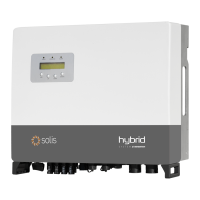8. Troubleshooting8. Troubleshooting
.67..66.
Alarms
Cause Solution
• Inverter detects grid
Frequency as too high
OV-G-F: Over
Grid Frequency
Test – DC switch OFF
• Check frequency at the inverter test points
• If Frequency measures high, adjust upper
limit with permission from utility
• Check LCD reading, may be a bad
measurement circuit
Test – DC Switch ON
• Check grid standard
• Replace inverter
NO-GRID
• Inverter does not
detect the grid
Test – DC switch OFF
• Check AC at the inverter test points
• L-L, L-GND
• Check LCD reading, may be a bad
measurement circuit
Test – DC Switch ON
• Check grid standard
• Replace inverter
OV-DC: DC
voltage is too
high
• Inverter detects High DCV
Test – DC switch OFF
• Check DC at the inverter test points
• If DCV is high, too many panels in the string
Test – DC Switch ON
• Check LCD reading, may be a bad
measurement circuit
• Replace inverter
OV-BUS: DC
BUS voltage is
too high
• Inverter detects High
DCV on internal bus
Test
• Measure DC and AC voltages
• Compare with LCD
• Replace Inverter
• Internal damage
• Wire came loose during shipping
UN-BUS: DC
BUS voltage is
too low
• Inverter detects low DCV
on internal bus
Test
• Measure DC and AC voltages
• Compare with LCD
• Replace Inverter
• Internal damage
• Wire came loose during shipping
Alarms
Cause Solution
• Input voltage low/missing
• Polarity reversed
• Main board damaged
No Information
(Blank Screen)
Test – DC switch OFF
• Check PV connections
• Check polarity
• Check voltage >860V
Test – DC Switch ON
• Check voltage >860V
• If DC voltage is “0” replace inverter
Initializing
(Inverter stuck
in this mode)
• Inverter is waiting for
driving signal
Test – DC switch OFF
• Check PV connections
• Check polarity
• Check voltage >860V
Test – DC Switch ON
• Check voltage >860V
• A cable may have been damaged or loosened
in shipping replace inverter
OV-G-V: Over
Grid Voltage
• Inverter detects grid
voltage as too high
Test – DC switch OFF
• Check AC at the inverter
• If AC measures high, adjust upper limit with
permission from utility
Test – DC Switch ON, full power
• Check AC at inverter test points
• Compare with LCD
• If AC measures high, cables between inverter
and interconnect are too small
• Check ampacity and voltage drop calculations
UN-G-V: Under
Grid Voltage
• Inverter detects grid
voltage as too low
Test – DC switch OFF
• Check AC at the inverter test points
• If AC measures low, adjust lower limit with
permission from utility
• Check LCD voltage reading, may be a bad
measurement circuit
Test – DC Switch ON
• Check grid standard
• Replace inverter
Screen OFF
with DC applied
• Inverter internally
damaged
• Do not turn off the DC switches as it may
damage the inverter.
Please wait for sunset and confirm the string•
current is less than 0.5A with a clip-on ammeter
and then turn off the DC switch. String current
above 0.5A is under load.
• Note: Damage due to wrong connections or fire
caused by removing string wires under load is
not covered in the device warranty.

